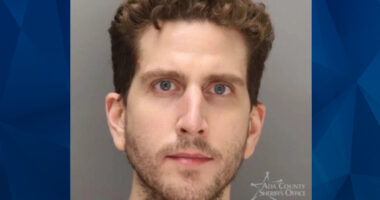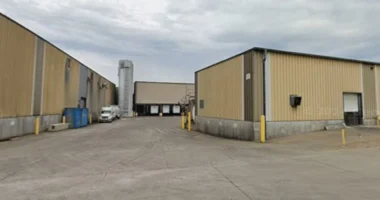FLYING over the dense jungles of Vietnam, these crop-duster planes brought death, destruction and deformities.

It’s nearly 50 years since the Vietnam War ended – but a battle is still being fought.
The human cost of the decades-long war was catastrophic for all involved. As many as two million civilians died.
The US military estimated that up to 250,000 South Vietnamese soldiers lost their lives – along with nearly 60,000 of their own troops.

Although the bloody war ended in 1975, the fight had only just begun for generations of Vietnamese families.
In 1962, John F Kennedy unveiled “Operation Ranch Hand” – a decision that would change the trajectory of millions of lives forever.

In a bid to expose the enemy in Vietnam’s dense jungle and farmland, the US military blasted dozens of regions with a weed killer.
It often appeared as an orange mist overhead and was sprayed by cargo planes and helicopters.

The US showered Vietnam with 80 million litres of the “exfoliating” chemical between 1962 and 1971 – on more than 6,500 flying missions.

It’s thought around 7,700 square miles of land was scorched – more than 20 per cent of South Vietnam’s forests.
Use the slider to see the catastrophic effects of the herbicide.
But the use of the chemical as a war tactic led to decades of torture.
An estimated three million people in Vietnam have been affected by crippling health problems linked to the toxic herbicide.
The figure includes 150,000 children born with severe birth defects – some of which are shown in shocking pictures.
This is the harrowing story of Agent Orange – one of the most savage chemical weapons ever used in warfare.

Also called the Second Indochina War, the Vietnam War began in November 1955 – and it dragged on for years.
One of the main reasons the United States joined the conflict was to prevent the spread of communism.
In the early 1960s, North Vietnamese soldiers had adopted a guerrilla warfare approach and were using the jungles and farmlands as cover.
The US came up with a plan.
They would spray a highly potent herbicide across vegetation in the to help with the war effort – and wipe out hideouts.
A chemical concoction – first used by the Brits in the Malayan Emergency – was made up and ordered to be sprayed across the country.
In 1962, the first flights were carried out in South Vietnam – with the US military “mapping targets” for the operations.
But the spray included dioxin – one of the most toxic chemicals known the man.
More than four million people are believed to have been directly exposed to the chemical.
Many of the aerial operations centred around three main regions in Bien Hoa, Da Nang and Phu Cat.
And it led to decades of torture.
The Red Cross say up to a million people have been left with a range of health problems linked to Agent Orange.
Newborn babies have been born with extra fingers and toes, faced severe facial disfigurements and suffered from mental disabilities.



Some have missing limbs, painful hernias and cleft palates which have severely hampered and shortened their lives.
And many children have been orphaned after being abandoned by their parents.
More than 100 youngsters are cared for by medical staff at the Ba Vi orphanage.



Their parents also developed diseases at an alarming rate.
And doctors and medical experts have blamed on Agent Orange for the life-altering health conditions.
Medics believe these generational issues have been spread through breast milk after a 1970s study found high levels of dioxin in South Vietnamese mothers.



Dao Van Loi, pictured below, joined Vietnam’s army in 1967 and took part in battles in Tay Mihn, near the border with Cambodia.
He’s seen holding his daughter Dao Thi Mai, who suffers from severe developmental and disability problems.
Loi says he was repeatedly exposed to Agent Orange – too many times to remember.

Several deadly types of cancer have also been associated with Agent Orange.
This includes chronic B-cell leukaemia, Hodgkin’s lymphoma, prostate cancer, respiratory cancer and lung cancer.
Despite the links between Agent Orange and the health issues, US officials downplayed the issue for decades.
They claimed the herbicide wasn’t capable of causing serious harm to humans – and many illnesses can’t be solely blamed on Agent Orange.
But a year after the war ended, Sweden’s former prime minister Olof Palme labelled the use of Agent Orange as an “ecocide”.
And in the years since, victims have filed a number of lawsuits against the developers of the chemicals.
Many families have suffered awful tragedies.
Tran To Nga, pictured below, has been looking for compensation for years after a series of family disasters.

The elderly woman has been at the forefront of the fight for more than a decade.
She claims that Agent Orange caused her to develop “repeated tuberculosis, cancer and type II diabetes”, according to a lawsuit.
The 82-year-old was first exposed to the harmful substance in 1966, the advocacy group Collectif Vietnam-Dioxine says.
She is still fighting for justice against a dozen companies who sold and produced the chemicals.
Her claim describes how her family have lived through tragedy after tragedy due to the impact of the weed killer.
You have to take yourself back 60 years when people were much less concerned about collateral damage or the long term health effects. I am sure they would have had a vague understanding that these things are dangerous
Hamish de Bretton-Gordon
Nga’s daughter died of a heart defect at 17 months – and her two other daughters and grandchildren all have “serious pathologies”.
Despite taking the accusations to court, Nga’s case has been rejected twice.
The judge found that the companies benefited from legal immunity due to their role within sovereign government.
The issue of compensation has raged on for years.
And no Vietnamese citizens have been handed compensation.
So far, only military veterans from the US, Australia and Korea have won compensation for the aftermath of the toxic substance.
The US government has yet to make full amends for the use of Agent Orange – either in the US or overseas.
But it has started a series of clean-up operations to help eliminate the chemical mess still lingering in Vietnam.
In 2019, America launched a multi-million dollar clean-up operation at an air base it used to store Agent Orange.
The Bien Hoa airport – outside Ho Chi Minh City – is considered the most contaminated in the country.

The chemical contaminated the soil – and seeped into nearby rivers.
America described the base as the “largest remaining hotspot” of dioxin in Vietnam.
Hamish de Bretton-Gordon – a former chemical weapons adviser for the British military – said countries were “much less concerned” about the collateral damage of the chemicals 60 years ago.
Mr de Bretton-Gordon said: “It’s an exfoliant. It kills leaves and stuff. So the reason behind it was so you could expose the enemy you’re fighting,
“This is a long time ago. This is way before drones and clever surveillance devices and everything else and was seen as a simple way to clear places where the enemy might be hiding.
“Of course, in Vietnam it was done on a massive, massive scale, but that was the basic, simple reason behind it – so you could better see your enemy who you were trying to either defend against or attack.
“You have to take yourself back 60 years when people were much less concerned about collateral damage or the long term health effects.
“That was not a key consideration. It was a very different time. They were just really focused on fighting and winning.
“Agent Orange and the herbicides that the Americans used were not being used as a chemical weapon to kill and injure the enemy, it was more to expose them.
“I am sure they would have had a vague understanding that these things are dangerous – they kill trees and stuff, they’re obviously toxic.”
Watch the video below to listen to Mr de Bretton-Gordon speak on Agent Orange and the impact of chemical war.
And the world’s wars have a long history of chemical warfare.
The French were among the first to ever drop chemicals when they used tear gas on their enemies in World War One but it was soon picked up by the Germans.
The first full-scale deployment of deadly chemical warfare agents was at the Second Battle of Ypres, on April 1915.
Germans attacked Canadian, French and Algerian troops with chlorine gas released from canisters which was carried by the wind towards the Allied trenches.
By 1939, the Hague Declaration had placed restrictions on the use of chemical weapons – something Western Allies followed throughout the conflict.
Nazi Germany and the Japanese did not cooperate and both used deadly gases.
The Imperial Japanese Army reportedly used tear gas, sneeze and nausea gas as well as mustard gas against Chinese troops.
Germany did decide against chemical attacks on the battlefield but the Holocaust still remains as the deadliest ever use of poison gas in history.
In the years following, several other conflicts involved chemicals.
Cuba were accused of using VX and sarin nerve agents against Angola by the United Nations.
In the Falklands, Argentina used nonlethal tear gas grenades on the British.
And Saddam Hussein ordered the use of several chemical weapons – severely injuring and killing his men and the enemy.
Some 100,000 Iranian soldiers were victims of Iraq’s chemical attacks – with the most common weapon being mustard gas.
Nerve gas agents also left around 20,000 Iranian soldiers dead, say reports.
The Syrian civil war has also reportedly seen sarin, mustard gas and chlorine all used in the last decade.
ISIS has also been accused of deploying chemical weapons out in the Middle East as they carry out their heinous attacks.
Russia’s Vladimir Putin has been blasted for his alleged use of toxic chemicals on Ukraine in the past.
Ukraine says they have faced over 700 gas related attacks on their troops by Russia since the outbreak of the war over 1,000 days ago.
But the scatter-gun approach of Agent Orange – and the harrowing long-term effects – makes it is one of the most savage uses of chemical warfare in history.



















